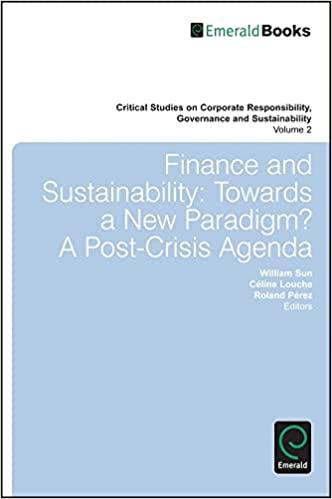Question
Consider a hedge fund that only runs for a year, and it has assets under management (AUM) of $1 billion. The manager is paid by
Consider a hedge fund that only runs for a year, and it has assets under management
(AUM) of $1 billion. The manager is paid by a standard 2+20 hedge fund
contract. That is, at the end of the year, he collects management fees of 2% of
AUM, and if the funds return is above 0% (the hurdle rate), he collects 20% of
that in performance fees.
For instance, suppose the funds return is 5%, which amounts to $1 billion 5%
= $50 million in dollar terms. The manager then collects $50 million 20% =
$10 million in performance fees, in addition to the $1 billion 2% = $20 million
management fees. If the funds return is below 0%, then the manager only collects
management fees.
(a) Please plot a graph that represents the managers total pay as a function of
the funds return. Specifically, fund return should be on the horizontal axis
and managers total pay is on the vertical axis.4 Mark the axis and values as clearly as possible.
(b) Let us now consider the risk-taking incentives of the fund manager. Suppose
the manager can take one of the two following strategies:
Strategy 1 yields a sure 5% return all the time. Thus, it is a strategy with
no risk.
Strategy 2 yields 20% return half of the time and -20% return the other
half of the time. Thus, it is a strategy with zero expected return and much
higher risk.
Because investors like higher returns and dislike risk, strategy 2 is dominated
by strategy 1. That is, it is worse than strategy 1 in terms of both return and
risk. Thus, if the manager chooses strategy 2, this is bad for investors.
Please compute the expected payoff5 of the manager under both strategies.
(c) Recall that hedge fund managers are relatively unconstrained in the strategies
they take. Further, since they do not need to tell investors what strategies
they choose, it is safe to assume that the hedge fund manager in this question
will choose whichever strategies gives him the highest expected payoff. Which
strategy, 1 or 2, will the manager choose?
(d) Now suppose the manager is only compensated with management fees but not
performance fees. In other words, the contract is similar to that used in mutual
funds. Assume that, if manager receives the same amount of expected payoff
from two strategies, he prefers the one with lower risk. Which strategy would
he choose?
(e) What do you learn from this exercise about how the structure of the hedge
fund manager contract, relative to the structure of mutual fund manager con-
tracts, induce risk-taking incentives in fund managers?
There is no absolutely correct answer. You will receive full credit as long as
you say something thoughtful and sensible.
Step by Step Solution
There are 3 Steps involved in it
Step: 1

Get Instant Access to Expert-Tailored Solutions
See step-by-step solutions with expert insights and AI powered tools for academic success
Step: 2

Step: 3

Ace Your Homework with AI
Get the answers you need in no time with our AI-driven, step-by-step assistance
Get Started


